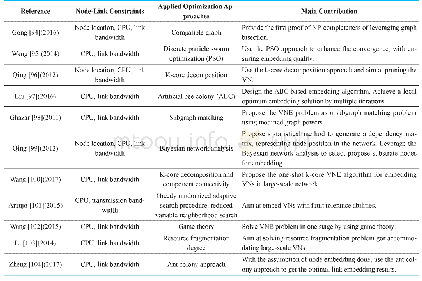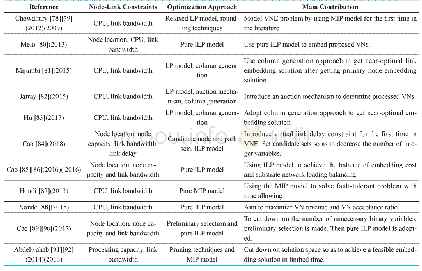《Table V.Latest and typical other family algorithms.》
 提示:宽带有限、当前游客访问压缩模式
提示:宽带有限、当前游客访问压缩模式
本系列图表出处文件名:随高清版一同展现
《A Survey of Embedding Algorithm for Virtual Network Embedding》
In ref.[113],Xiao et al.proposes another SVNE algorithm with the topology awareness to solve multiple substrate node failures.Previous SVNE algorithms,such as[114],[115],[116]and[117],aim to ensure the SN survivability against single substrate node failure in a cost-effective way.Objects of ref.[113]are to increase the long-term embedding revenue by ensuring a certain VN request acceptance ratio and to reduce the penalty incurred by substrate node failures.Xiao et al.constructs the Candidate Node Set of each virtual node at first.To each virtual node,the specific substrate node,having the highest probability among the nodes in the Candidate Node Set,is selected to replace the former substrate node that has been embedded onto the virtual node.Primary and backup node resources are defined in ref.[113].A recoverability-based VNE algorithm(R-VNE),adding a higher recoverability to the objective function of MIP model[78],is adopted to embed VNs in the first stage.When any substrate node failure exists,a profit-driven VNE algorithm(PD-VNE)is adopted to fulfill the node embedding.Simulation results reveal that R-VNE and PD-VNE outperform the MIP model[78]in terms of long term VN embedding revenue,with substrate resource usage percentage up to70%and VN request acceptance ratio.Many other latest or typical SVNE algorithms have been proposed(Table VI).
| 图表编号 | XD00127827200 严禁用于非法目的 |
|---|---|
| 绘制时间 | 2019.12.15 |
| 作者 | Haotong Cao、Shengchen Wu、Yue Hu、Yun Liu、Longxiang Yang |
| 绘制单位 | Jiangsu Key Laboratory of Wireless Communications, Nanjing University of Posts and Telecommunications、Jiangsu Key Laboratory of Wireless Communications, Nanjing University of Posts and Telecommunications、Department of Key Accounts, China Mobile Group Jian |
| 更多格式 | 高清、无水印(增值服务) |





